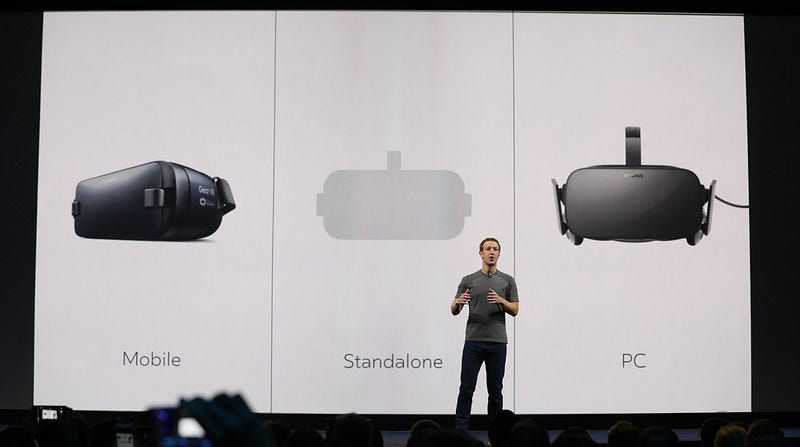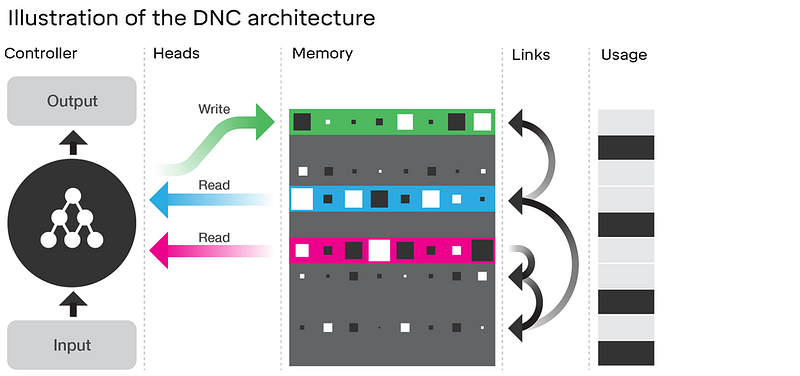Oculus Connect 3, Differential Neural Computers, and Security Flaws in Connected Medical Devices
Oculus Connect 3, Differential Neural Computers, and Security Flaws in Connected Medical Devices
- Last Updated: December 2, 2024
Yitaek Hwang
- Last Updated: December 2, 2024



Oculus Connect 3
At Oculus Connect event last week, Mark Zuckerberg introduced Santa Cruz, a standalone version of the Oculus Rift that claims to be the middle-ground between mobile VR sets like Samsung’s Gear VR and PC-connected devices. Facebook’s CEO also announced motion controllers, in-ear headphones, customizable avatars, and partnerships with Disney and the gaming industry.

Summary:
- Santa Cruz takes advantage of what Facebook calls “inside-out tracking,” where sensors are now integrated into the headset to capture the movement of the user (previously sensors had to be installed externally).
- Santa Cruz is smaller than Intel’s Project Alloy, and from the demos that Mark Zuckerberg walked through, it seems to be very functional.
- Facebook envisions a new ecosystem called the VR Web: Oculus avatars will be available early 2017 along with social platform called parties.
Takeaway: The standalone product opens up another market in the VR segment. The inside-out tracking ability helps to appeal more to this mobile generation, freeing the VR headset from external sensors or connected PC. Looking at this with IoT in mind, I still believe there is more potential with AR than VR, especially in having virtual beings interact more naturally with physical surroundings. Still as hardware catches up to our futuristic dreams, one can’t help but be excited for the commercial release of VR/AR products.
+ Youtube: Q&A with Tim Cook on the future of AR & VR
Differential Neural Computer — AI with a Working Memory
Google’s DeepMind published a new paper in Nature describing its new architecture called Differential Neural Computer (DNC). DNC combines deep learning with a controller that stores knowledge in an external memory. Although technical challenges — including scaling and giving AI the human ability to quickly learn new task — remain, DNC elevates the state of AI research closer to achieving human-like abilities.

Summary:
- Deep learning architectures, when given a large amount of training data, excel at pattern recognition (e.g. convolutional neural nets for computer vision), but are still limited for tasks requiring logic and reasoning.
- DeepMind’s DNC addresses some of these issues by adding an external memory to the deep learning architecture. The controller maps the connections between the memory and the neural net to deduce complex relationships.
- According to Ruslan Salakhutdinov, an associate professor at CMU specializing in ML and AI, DNC can help perform useful tasks in the future if it can figure out a way to scale; backpropagation calculations required to access memory upon a query is computationally expensive.
Takeaway: The biggest limitation of current ML systems is that they cannot store what they have learned for future applications. Recurrent Neural Networks, for example, provide some notion of memory in Natural Language Processing applications, but most AI systems take in specific datasets for training and perform particular tasks. DNC can jumpstart a series of new research in ML and AI that may enable more human-like abilities.
Quote of the Week
Attacks could be made for a variety of reasons including blackmail, malice against an individual, or manipulation of a politically notable individual. The motive need not even be rational; in 2008 a website for epilepsy sufferers was attacked using flashing images designed to trigger seizures, with the attackers’ apparent motivation being amusement.
- Excerpt from “Brainjacking: Implant Security Issues in Invasive Neuromodulation” by Pycroft et al.

Two weeks ago, I covered the security flaws that are left unaddressed in IoT. While concerns over personal privacy are legitimate, vulnerabilities to hacking medical devices — dubbed brainjacking by a group of neurosurgeons — are downright terrifying. Rapid7 reported earlier that Johnson & Johnson’s Animas OneTouch Ping insulin pump can be easily hacked due to a lack of encrypted communication protocol.
Johnson & Johnson’s letter to its users to warn them of this vulnerability simply advises them turn off the radio in the pump when not in use. It is time to start designing connected devices with security in mind. Maybe someone hacking into our smart thermometers may not have significant impact, but someone taking control of pacemakers or brain implants can have serious ramifications.
The Rundown
- Wrist-controlled smartwatch — TechCrunch
- 27 Jupyter Notebook tips and tricks — DataQuest
- Case for USPS buying Twitter — Medium
- Data Science for IoT — KDnuggets
- Complete guide to AWS — GitHub
Resources
- Yarn: New package manager for JS
- ViewedIt: Easily create and track video for free
- Marathono: GUI tool for managing processes on macOS
- Tesseract.js: JS multilingual OCR
- TagSpaces: Open source personal data manager
The Most Comprehensive IoT Newsletter for Enterprises
Showcasing the highest-quality content, resources, news, and insights from the world of the Internet of Things. Subscribe to remain informed and up-to-date.
New Podcast Episode

How to Build Smart Building Solutions
Related Articles





